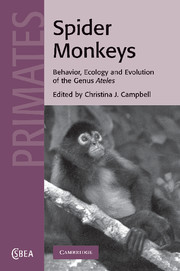Book contents
- Frontmatter
- Contents
- List of contributors
- Acknowledgements
- 1 Introduction
- Part I Taxonomy, phylogeny and evolution
- Part II Ecology
- 4 Diets of wild spider monkeys
- 5 Factors influencing spider monkey habitat use and ranging patterns
- 6 Spider monkeys as seed dispersers
- Part III Behavior and reproduction
- Part IV Interactions with humans
- Index
- References
5 - Factors influencing spider monkey habitat use and ranging patterns
Published online by Cambridge University Press: 05 May 2010
- Frontmatter
- Contents
- List of contributors
- Acknowledgements
- 1 Introduction
- Part I Taxonomy, phylogeny and evolution
- Part II Ecology
- 4 Diets of wild spider monkeys
- 5 Factors influencing spider monkey habitat use and ranging patterns
- 6 Spider monkeys as seed dispersers
- Part III Behavior and reproduction
- Part IV Interactions with humans
- Index
- References
Summary
Introduction
The main influence on primate ranging behavior is food abundance and distribution (Clutton-Brock, 1977; Bennett, 1986). Temporal variations in the availability and distribution of preferred resources shape primates' ranging patterns (Zhang and Wang, 1995; Agetsuma and Noma, 1995; Defler, 1996; Olupot et al., 1997), and can affect the size and shape of home ranges (Harvey and Clutton-Brock, 1981). Other factors known to affect primate ranging behavior include the position of water resources (Altmann and Altmann, 1970), location of sleeping sites (Rasmussen, 1979; Chapman et al., 1989), climatic extremes (Chivers, 1974), the need to patrol boundary areas of the home range (Goodall, 1986; Watts and Mitani, 2001; Williams et al., 2002), and variation in the perceived predation risk of differing habitats (Cowlishaw, 1997).
As large ripe fruit specialists, spider monkeys (Ateles spp.) are known for their relatively wide ranging behavior (van Roosmalen and Klein, 1988; Symington, 1988; Chapman, 1990; Castellanos, 1995; Nunes, 1995; Shimooka, 2005; Wallace, 2006), with only Lagothrix, Cacajao, Chiropotes, Brachyteles and possibly Oreonax displaying comparable or larger ranges within the New World monkeys. Published accounts of Ateles home range sizes vary between 95 and 390 hectares in continuous forests (Table 5.1), and the Barro Colorado Island group ranges more than 900 hectares (Campbell, 2000). As such several distinct habitat types are found in most spider monkey territories (Table 5.1).
- Type
- Chapter
- Information
- Spider MonkeysThe Biology, Behavior and Ecology of the Genus Ateles, pp. 138 - 154Publisher: Cambridge University PressPrint publication year: 2008
References
- 30
- Cited by



